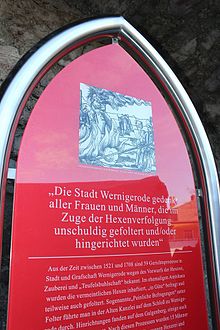Mette Fliss
Mette Fliß († July 17, 1583 in Wernigerode ) was publicly burned at the stake with three other women during the witch hunt in the county of Wernigerode (Harz).
Political situation in Wernigerode
After the death of Count Wolfgang zu Stolberg there were numerous attempts between his brothers and children to rule the various Stolberg possessions. Again and again, new contracts were concluded with each other, which were often only of short duration. For a certain time, Count Albrecht Georg zu Stolberg and his younger nephew Wolf Ernst zu Stolberg ruled together over the Stolberg County of Wernigerode. When Albrecht Georg died in 1587, the Stolberg possessions were again divided up until 1588 and again in 1589. Only from this point in time was Count Wolf Ernst sole regent of the County of Wernigerode.
Around 1580 there were disputes between the Counts of Stolberg and Elector August of Saxony over feudal issues and from 1585 because of support for Anna III. zu Stolberg , Abbess of the Quedlinburg Monastery . In the run-up to the ceremonial inauguration of Anna, her relatives present, Count Albrecht Georg zu Stolberg and Count Wolf Ernst zu Stolberg, were secretly kidnapped from Quedlinburg Castle in January 1585 on behalf of the Elector of Saxony and imprisoned at Hohnstein Castle for several weeks .
Against the background of these foreign policy disputes, the wave of witch trials could have represented an internal political function of a show of power.
Wave of witch trials
The trial of Andreas Meinicke in 1581 was followed by a wave of witch trials that lasted until 1588. You fell victim:
- 1582 the Niemannsche
- 1583 Catharina Teichgräber
- 1583 Hans Winters (son of Margaretha Schrader from Quedlinburg, burned as a witch)
- 1583 Anna Suprangin
- 1583 Mette Fliß
- 1583 Margaretha Ludwig
- 1583 the 86-year-old Mrs. Volkmann (Volgmensche)
- 1583 Also shown were the Friedrichin and
- 1583 the Jürge (young) Trümpelmenschin
- 1583 Margarethe Lange (the old Trümpelmann)
- In 1587 three sorceresses were sentenced to death by fire
- 1588 Lüdecke Hock
- 1588 Anna Förster called Krimpe (executed with the sword)
- 1588 Margarethe Hentzin (Grünrocksche)
Witch trial
When a wave of witch persecution began in the county of Wernigerode, Mette Fliß from Drübeck was one of the first women to be arrested in a chain trial. During the interrogation, she testified that a Buhle Lucifer assigned to her by a neighbor had been dressed in green, had a cow's foot and a human foot, and had appeared to her for the first time at the hedge near Silstedt . He was a beautiful young journeyman who appeared to her often, wanted to teach her fortune-telling from the crystals and also visited her secretly in custody.
Even before the torture was applied, she said that from gold root (= celandine ?) That grows under the fences, brown cans and caraway seeds can be made into a healing potion. During the embarrassing questioning, she was tortured and confessed that she was guilty of the illness of a child and a mercenary . Mette Fliß was sentenced to death by fire in this trial for being a devil's partner and was executed on July 17, 1583 along with three other women.
Commemoration
On April 6, 2011, Andreas Vogt submitted an application to the City Council of Wernigerode to rehabilitate the victims of the witch trials for moral and socio-ethical reasons. The culture committee and the city council have not yet made a decision. On January 21, 2017, a memorial plaque for the victims of the witch trials at the old office building was set into the historic city wall.
See also
literature
- Journal of the Harz Association for History and Antiquity, 1871, p. 292
- Georg von Gynz-Rekowski : Witches' Protocols from the County of Wernigerode 1583–1588–1597 , Wernigerode 1971, (typewritten manuscript in the Harz Library Wernigerode, online (PDF) )
- Jörg Brückner : Witch trials in the city and county of Wernigerode as socio-historical sources , in: 775 Years of Wernigerode City Law , pp. 58–70
Individual evidence
- ↑ Names of the victims of the witch trials / witch persecution Wernigerode (PDF; 30 kB), accessed on May 9, 2016.
- ↑ Samuel Buchholz, Oberpfarrer zu Lichen in the Ukermarck: attempt of a history of the Churmarck Brandenburg from the appearance of the German Sennonen up to the present time, third part: new history . Berlin by Friedrich Wilhelm Birnstiel, Königl. privil. Buchdrucker, 1767, p. 500.
- ↑ Application by Andreas Vogt for the rehabilitation of the victims of the witch trials by the council of the city of Wernigerode (PDF; 397 kB)
| personal data | |
|---|---|
| SURNAME | Fliss, Mette |
| BRIEF DESCRIPTION | German woman, executed as a witch |
| DATE OF BIRTH | 16th Century |
| DATE OF DEATH | July 17, 1583 |
| Place of death | Wernigerode |
